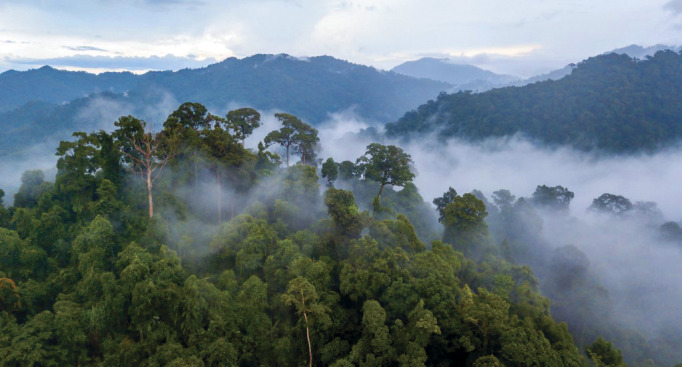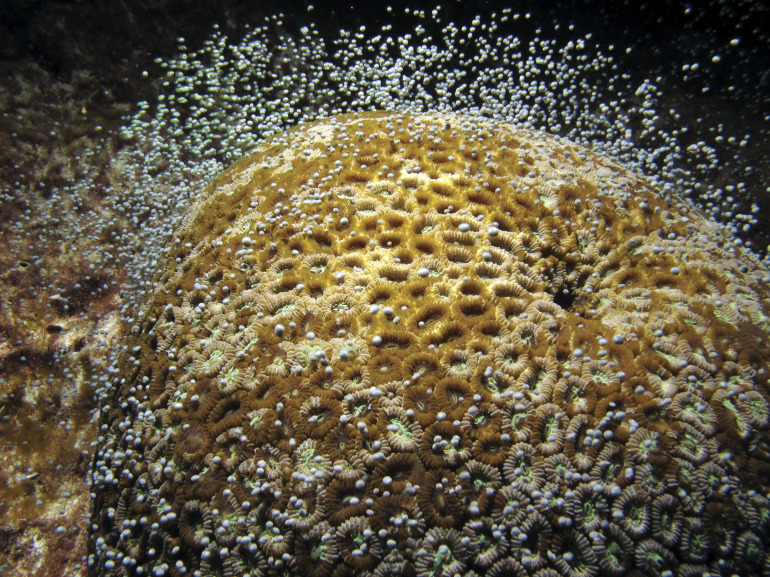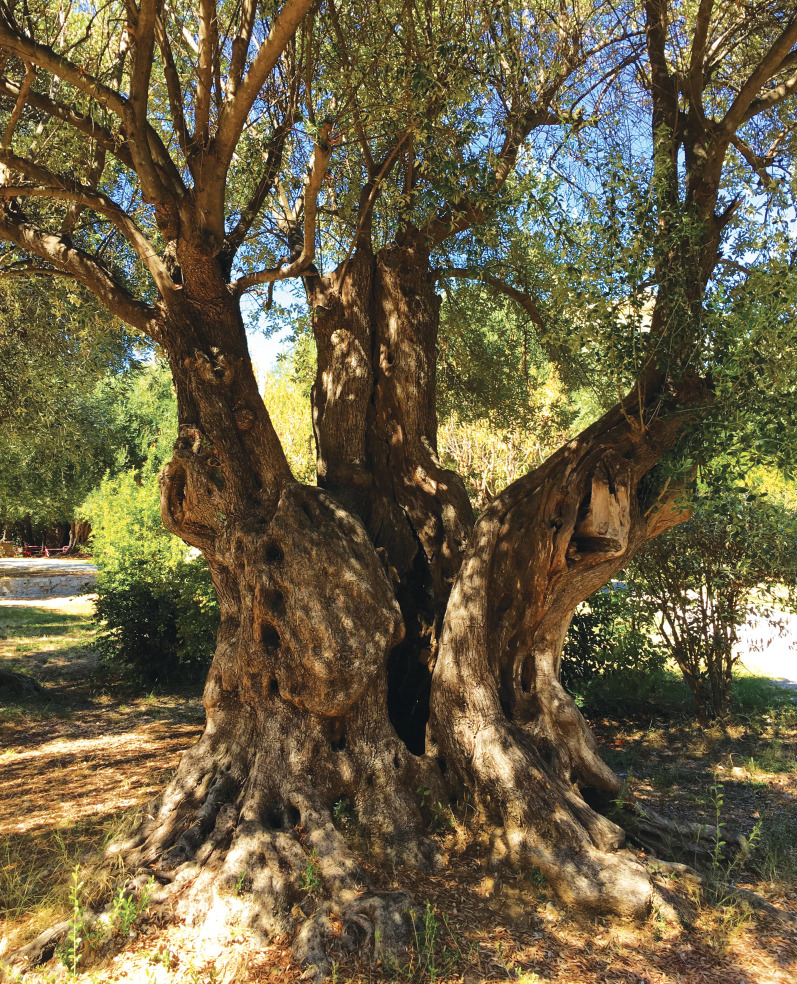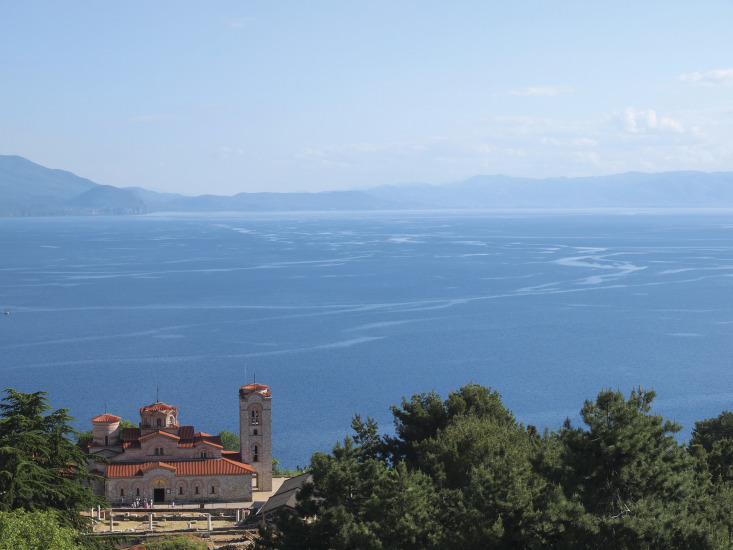ENVIRONMENTAL SCIENCES
D. speciosa releasing egg-sperm bundles during mass coral spawning in Taiwan.
Lunar-synchronized spawning in corals
Synchronized mass spawning in corals occurs annually over the course of a few nights following a full moon. Although moonlight is thought to regulate coral spawning, how corals sense moonlight signals to determine the day of spawning is unclear. For 3 years, between the months of April and May, Che-Hung Lin et al. examined the spawning behaviors of the coral Dipsastraea speciosa. Corals near Green Island, Taiwan, were shaded from sunset to sunrise up to 3 days before a full moon or for 1 day after a full moon. Regardless of when moonlight was blocked, spawning occurred on the fifth night following blocked moonlight. However, unshaded corals exposed naturally to the sky spawned on the sixth night following a full moon. Spawning was also suppressed in corals exposed overnight to dim light mimicking moonlight—either in a tank or in the field. The effects were similar, regardless of the light spectra to which the corals were exposed. The findings suggest that the period of darkness between sunset and moonrise following the night of a full moon triggers synchronized mass spawning of D. speciosa and eliminates the suppressive effect of continuous light on spawning, according to the authors. — M.S.
EVOLUTION
Deep geology and evolution of Jehol Biota
The Jehol Biota is an Early Cretaceous ecosystem represented by exquisitely well-preserved fossils, including soft tissues and feathers. The fossil bed lies atop the North China Craton, a formerly stable section of continental plate that was in the process of becoming unmoored 125 million years ago. Zhonghe Zhou et al. reviewed the Early Cretaceous geology and paleontology in northern China and found a link between regional tectonics and terrestrial evolution. Given the overlap in time of the fossil preservation and craton destabilization, the authors explored the potential effects of craton destruction on the evolution of the Jehol Biota. The authors examined surface effects generated by the subduction of the paleo-Pacific plate. Rift basins and volcanic eruptions shifted eastward as the subduction progressed, and the shift is consistent with the eastward expansion of the Jehol Biota in north and northeast China. The distribution of the Jehol Biota also appears closely related to volcanic intensity in both space and time. According to the authors, these links provide an example of how deep tectonic geology may have controlled the evolution of life on the surface and suggest new avenues for studying the ancient biosphere. — T.H.D.
AGRICULTURAL SCIENCES
Sweet and pungent pepper (C. annuum) cultivars.
Diversity and distribution history of peppers
Used in cuisines across the globe, the Capsicum pepper includes species of varying shapes, flavors, and pungency. Prior research suggests that peppers spread across Eurasia during the 16th century after Christopher Columbus’ travels from the Americas back to Europe. However, whether the spread of peppers involved links between East and Southeast Asia and the Americas is unclear. To examine the genetic diversity of peppers across the globe, Pasquale Tripodi, Mark Timothy Rabanus-Wallace, et al. genetically analyzed more than 10,000 wild and domesticated Capsicum accessions. Peppers from Mesoamerica and South America spanned almost the entire main diversity cline of Capsicum annuum, the most widely consumed species of peppers. The authors identified Africa, East Eurasia, Mesoamerica, and South America as primary hubs of diversification and expansion of domesticated peppers. Peppers from Africa overlapped with peppers from South America as well as East and Central Asia. The authors suggest that the overlap likely occurred due to transatlantic trade, including slave trade, during the 16th century, as well as Portuguese maritime trade routes around the Cape connecting with coastal trade along southern Eurasia. Pungency levels were not distributed uniformly in peppers across the globe, suggesting that human preferences influenced the genetic structure of domesticated peppers, according to the authors. — M.S.
ECOLOGY
An ancient olive tree (Olea europaea) in Cap d’Antibes, France.
Fecundity of large, aging trees
Trees are essential to both ecosystems and human health. However, trees in fruit and nut orchards are often replaced after several decades, before yields decline. How fecundity, the physiological potential to reproduce, changes as trees grow and age remains unclear, with most ecological studies assuming that fecundity increases indefinitely. Tong Qiu et al. examined fecundity data for 585,670 trees representing 597 species worldwide from the Masting Inference and Forecasting project. The dataset accounted for trees’ seed and crop production as well as maturation status and included substantial representation of large trees; small trees often dominated prior research. Overall, the authors found, fecundity decline with size was pervasive, occurring in 80% of tree species. Most of the remaining 20% of species did not have many large trees in the dataset. The findings suggest that fecundity is either optimal or reaches a plateau when trees are of intermediate size. The findings carry implications for human fruit and nut consumption as well as for food webs in forests, according to the authors. — M.S.
ECOLOGY
Lake Ohrid.
Mediterranean forest refugium and glacial–interglacial cycles
The responses of forest refugia to previous climatic changes have not been well documented. Timme Donders et al. analyzed pollen and spores in sediment samples from the Lake Ohrid catchment on the border of Albania and North Macedonia to identify the taxa and relative abundances of forests in the region across the last 1.36 million years of glacial–interglacial cycles. The authors report that the catchment initially had high tree abundances, transitioning around 1.16 million years ago to an increased fraction of herbs and semiarid shrubs due to an increase in aridity and a deepening of Lake Ohrid. Another transition to increased vegetation variability between increasingly long and high-amplitude glacial–interglacial cycles followed around 0.94 million years ago. Taxa that were extinct or rare elsewhere showed high abundance and diversity in the Lake Ohrid catchment, demonstrating its role as a refugium, until around 1 million years ago, after which the taxa occurred in decreasing frequencies before disappearing. According to the authors, the Lake Ohrid record can provide information about the resilience of forests to future climate change. — M.H.
ECONOMIC SCIENCES
Economic impacts of climate tipping points
Climate tipping points represent a phenomenon in which small perturbations can switch large-scale Earth subsystems into a qualitatively different state. Simon Dietz et al. report geophysically realistic estimates of the economic impacts of all eight climate tipping points covered in the climate economics literature. The authors’ integrated model represents the effects of rising temperatures and sea levels in 180 countries. The tipping points are categorized as positive carbon-cycle and temperature feedbacks, ice sheet disintegration, and changes in large-scale circulation. When comparing the presence versus the absence of climate tipping points, 98% of countries experience an increase in the social cost of carbon (SCC), defined as the economic cost of emitting one additional ton of CO2. Collectively, the climate tipping points increase SCC by 25%, but the authors report a 10% chance that climate tipping points will more than double the SCC. The largest effects are produced by the dissociation of ocean methane hydrates and thawing permafrost, which increase SCC by 13.1% and 8.4%, respectively. Because SCC is a key economic metric used in climate policy discussions, the findings could influence carbon prices and mitigation efforts, according to the authors. — J.W.
ENVIRONMENTAL SCIENCES

The water that forests release into the atmosphere can stabilize rain cycles in distant areas, according to a recent study. Image credit: Shutterstock/Richard Whitcombe.
Forests fight drought, even from far away
Posted on August 13, 2021
Amy McDermott
Forests are said to be the lungs of the Earth—they also provide a moist breath that travels tens to thousands of miles. Dense stands of trees release foggy clouds of condensation. The water molecules from those clouds ride wind currents before falling back down as rain. Places that rely on precipitation from this forest moisture have more stable rain cycles, meaning less variation month to month, than where rain comes from nonforest sources—this, according to a recent study in Global Change Biology. “The main takeaway is that forests around the globe help to regulate rainfall,” says lead author John O’Connor, a PhD student at Utrecht University in the Netherlands.






